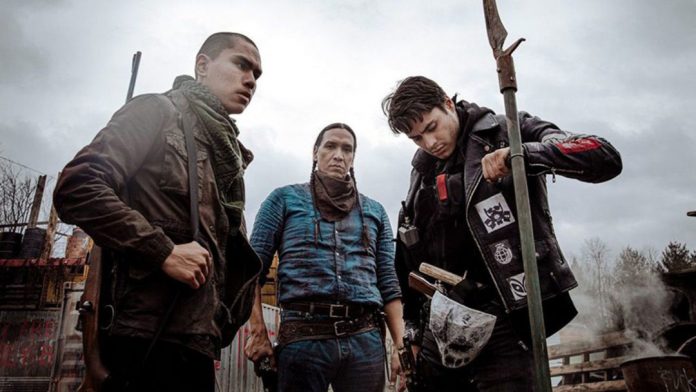What if the next pandemic struck — and you were naturally immune?
This is the gripping premise of Jeff Barnaby’s Blood Quantum (2019), a razor-sharp zombie thriller that sinks its teeth deep into Indigenous resistance.
On the isolated Red Crow Mi’kmaq reserve, a fictional reserve shown in the moive, an extraordinary discovery unfolds: while the outside world crumbles under a zombie plague, the Indigenous community stands mysteriously immune. In the 96 heart-pounding minutes, Barnaby weaves together graphic horror and a powerful social message.
At the core of this apocalyptic tale lies a complex family drama: Sheriff Traylor (Michael Greyeyes) navigates relationships with his ex-girlfriend Joss (Elle-Máijá Tailfeathers), their son Joseph (Forrest Goodluck) and his troubled older son from a previous relationship, Lysol (Kiowa Gordon).
The film hooks you from its first bizarre moment — a Mi’kmaq fisherman’s routine day turns surreal when his gutted catch starts thrashing with impossible life. (Zombie fish? Now that’s a fresh catch no one ordered!)
As the dead rise with an appetite for human flesh, we fast-forward six months to find a community adapting to its new reality, where survival means learning to live alongside the ravenous undead. Since non-Indigenous people remain vulnerable to the plague, trust becomes a scarce commodity among the survivors.
The film’s brilliance lies in its clever twist on typical zombie stories by making Indigenous people immune to the zombie virus – serving as a powerful metaphor for how Indigenous communities have historically endured and survived countless hardships, from diseases to colonial oppression.
Building on this foundation, the narrative fearlessly confronts contemporary Indigenous issues — generational trauma, identity struggles and community governance during crisis.
Supporting these themes, the masterful cinematography creates a visual storytelling experience where precise camera work dances with tension — swooping, lurking and striking to keep viewers engaged.
Barnaby’s artistic choice to film violent scenes from a distance, rather than using close-up shots, sets this film apart from typical zombie movie gore.
Particularly noteworthy is Stonehorse Lone Goeman’s profound performance as Gisigu. His character embodies a deep, almost spiritual connection to the land that transcends the chaos of the zombie apocalypse.
Through Gisigu’s eyes, we witness not just survival, but a fundamental understanding of what it means to be a guardian of ancestral territories. His unwavering devotion to protecting both the land and his people serves as a powerful reminder of Indigenous Peoples’ enduring relationship with their traditional territories, even in the face of unprecedented horror.
Despite the film’s stunning visuals and deep themes, its second half loses momentum. The narrative shifts from heart-pounding horror to a slower meditation on relationships and survival, reducing the tension that powered its first half.
Like their ancestors who survived many challenges throughout history, the Indigenous characters in the film are immune to the zombie virus. This could have been a great opportunity to explore deeper ideas about cultural strength and spiritual resilience, but the film doesn’t fully develop these themes.
While Michael Greyeyes delivers a compelling performance as Traylor, the development of Lysol’s character falls short. The film fails to properly establish his transformation into an antagonist, presenting an abrupt shift in his character without adequate exploration of his motivations or past experiences.
In the end, Blood Quantum is not just another zombie flick – it’s a powerful story about survival, family, and protecting what matters most.
Through its blood-soaked lens, we’re forced to confront uncomfortable truths about who we choose to save and why. While the zombies may feast on flesh, it’s the film’s unflinching examination of humanity’s moral choices that truly gets under your skin.
Barnaby’s masterpiece does double duty – it’ll make you jump out of your seat while also sparking important conversations about Indigenous experiences in today’s world.
Whether you’re here for the thrills or the thought-provoking message, Blood Quantum proves that horror can be both scary and smart, leaving its mark on both the zombie genre and Indigenous storytelling.




